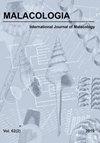Validation by qPCR of Reference Genes for Reproductive Studies in the Invasive Apple Snail Pomacea canaliculata
IF 1
4区 生物学
Q4 ZOOLOGY
引用次数: 4
Abstract
ABSTRACT The South American freshwater gastropod Pomacea canaliculata is a highly invasive species. In introduced areas, it is a serious crop pest, responsible for great economic loss and ecological damage. It is also a vector of the nematode Angiostrongylus cantonensis that causes human meningoencephalitis. Many aspects and particularly its reproduction have been extensively studied, but little research has been conducted on this species regarding gene expression. To meaningfully interpret quantitative PCR, a powerful technique to develop this kind of study, validation of reference genes is essential but until now has not been undertaken. We selected the female albumen gland for its major role in egg production in order to evaluate the expression stability of the candidate reference genes EF1-α, RPL7, His H3.3, TUBB, 18S RNA, ACTB and GAPDH. Stability was analyzed under different reproductive activity conditions and defined based on three approaches: geNorm, NormFinder and the comparative ΔCt method. NormFinder selected GAPDH and ACTB as the best option to be used for normalization, whereas geNorm and the comparative ΔCt method indicate RPL7, GAPDH, and 18S RNA as the most stable genes under the conditions studied. These results will facilitate reproductive studies, particularly those using qPCR to evaluate factors that may affect fecundity of this conspicuous invasive species.应用qPCR技术对苹果蜗牛生殖研究中参考基因的验证
南美淡水腹足动物Pomacea canaliculata是一种高度入侵物种。在引种地区,它是一种严重的农作物害虫,造成巨大的经济损失和生态破坏。它也是引起人类脑膜脑炎的广州管圆线虫的载体。许多方面,特别是其生殖已被广泛研究,但对该物种的基因表达的研究很少。为了有意义地解释定量PCR,一种强有力的技术来发展这类研究,内参基因的验证是必不可少的,但到目前为止还没有进行。为了评价候选内参基因EF1-α、RPL7、His H3.3、TUBB、18S RNA、ACTB和GAPDH的表达稳定性,我们选择了在产蛋过程中起主要作用的雌性蛋白腺。通过geNorm、NormFinder和comparative ΔCt三种方法对不同繁殖活动条件下的稳定性进行了分析和定义。NormFinder选择GAPDH和ACTB作为归一化的最佳选择,而geNorm和比较ΔCt方法表明RPL7、GAPDH和18S RNA是所研究条件下最稳定的基因。这些结果将有助于生殖研究,特别是那些使用qPCR来评估可能影响这种显著入侵物种繁殖力的因素的研究。
本文章由计算机程序翻译,如有差异,请以英文原文为准。
求助全文
约1分钟内获得全文
求助全文
来源期刊

Malacologia
生物-动物学
CiteScore
2.00
自引率
0.00%
发文量
15
审稿时长
3 months
期刊介绍:
Malacologia publishes papers on all groups of the Mollusca. Malacologia specializes in publishing long papers and monographic treatments. Complete data are especially appreciated. Papers must be of interest to an international readership. Papers in systematics, ecology, population ecology, genetics, molecular genetics, evolution and phylogenetic treatments are especially welcomed. Also welcomed are letters to the editor involving papers published or issues of import to science of the day.
 求助内容:
求助内容: 应助结果提醒方式:
应助结果提醒方式:


